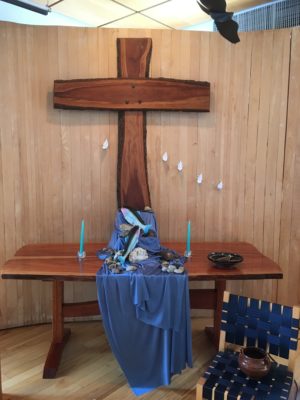 July 29, 2018
July 29, 2018
Tenth Sunday after Pentecost
We all come into the world with unique potentials. When one of these potentials seems to stand out, claim our attention and engage our emotions, we may be looking at a “call,” telling us that we can use that ripened potential in a positive way. We can find the vocation that is related to our deepest self, a path that will help that self to unfold.
I notice design. I love color. My call to making and teaching art grew out of childhood experiences and ripened through the years. As a child, my mother delighted in nature and my grandmother had a wildflower garden. Together, we noticed flower and leaf shapes, different habitats in sun-drenched soil, lichen-covered rocks, the dark brown rich soil of deep woods and squishy wetlands. We noticed the variety of birds, butterflies and bugs – all parts of the grand assortment of summer wildlife.
Although there was some recognition of my artistic expression in grade school by parents and teachers, it wasn’t until I graduated from college with a degree in Education and minor in Group Work, and had a couple of years as Teen Age Program Director for a small YWCA, that I realized it was the creative work done in those settings, with teens and younger children that spoke to my spirit. I enjoyed teaching. And I enjoyed art.
Sooooo, I resigned my job at the Y, and became a secretary at Columbia Teachers College in order to get tuition-free credits in Art Education. That done, I moved to Philadelphia, where I taught art at an elementary school in a diversely populated neighborhood. The most rewarding part of my teaching was seeing the uniqueness of each student’s noticings and how they chose to express those noticings. I remember a first grader, who re-lived his Halloween trick-or-treating of the night before. After he had experienced the whole evening in words and in paint strokes, he ended up with a paper largely covered with a muddy color, but he had found a way to recall each important part of the experience as he moved his brush. The incoherent picture had helped him find his voice.
After I had taught three years, and co-directed an art program at a summer camp, I was making plans for further education when I met John Adams, the older brother of a friend of mine. My plans changed! We married. And though I continued to teach, my life at home was family-centered. John came with twins, boy and girl in 8th grade; an older boy in 12th grade, and we later adopted an almost 9-year-old girl. Life was full of family!
Looking back, I realize that when I joined the Adams family, I was fulfilling a yearning from part of my childhood. I had wanted to be adopted away from my own family. My parents’ marriage had crumbled. I was blamed for my sister’s illness and not spoken to or regarded for several months. So, although being a step-mother was a challenge, I was in a family which communicated, and was used to working together! My listening skills improved. I paid attention to humor. There were many learnings and much enjoyment!
The Work Within
In Cry Pain, Cry Hope, Elizabeth O’Connor writes: “Every single one of us has a “good work” to do in life. This good work not only accomplishes something needed in the world, but completes something in us…. The work we do in the world, when it is true vocation, always corresponds in some mysterious way to the work that goes on within us.’’
John died before I retired from teaching. With the family launched, retirement brought me to another turning point in my call. A friend mentioned Christ House, a residential medical facility in Washington, serving ill or injured homeless men. Janelle Goetcheus, its director, was a doctor who wanted to serve people who otherwise would not be able to receive full medical care. She was inspired by the emphasis on “call” by The Church of the Saviour, and, with others who learned of her vision, worked to bring this dream into reality.
Janelle had followed the quest to find the vocation related to her deepest self and that would help that self to unfold. Christ House is a community in which the patients are treated with caring and respect. It is designed to help them with their needs, not only physically, but in other ways through AA meetings, music, art workshop, worship, field trips, library trips, and case management to help them plan for what they will do when they leave Christ House. The usual stay is for about 40 days. However, the determining factor is how long it takes for healing, so there are those whose stays are longer. In 1993, I began offering a weekly art workshop there.
The residents have had varied expiriences with self-expression in art. I usually demonstrate how to use a particular medium, and then invite the participants to experiment themselves. Occasionally, we will have a “how-to” session, for instance, how to divide up the face when making a portrait…Where do eyes go, nose, mouth? Sometimes there will be some objects on the table as possible stimulants for art work. We will have a short time of looking at them, noticing various aspects of them….some people will note shape first, others color, but I want to encourage art that comes from a feeling place rather than building skills.
An assortment of materials on the art cart allows for different kinds of projects: tempera paints, watercolors, colored markers, pastels, colored tissue paper, rubber stamps and blank cards and envelopes. I want to help these healing men find their voices through art. Seekers Church has a Domestic Giving program, and provides the money for the art workshop’s materials. It also supports the work of Christ House.
Here are some examples of work done by Christ House residents. A note here: In its beginning women were also residents. There was a policy change shortly after I began volunteering there.
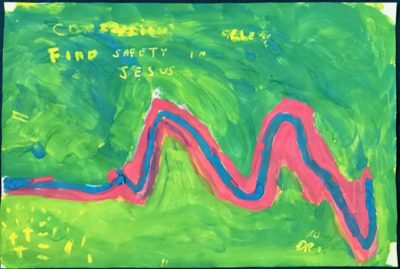
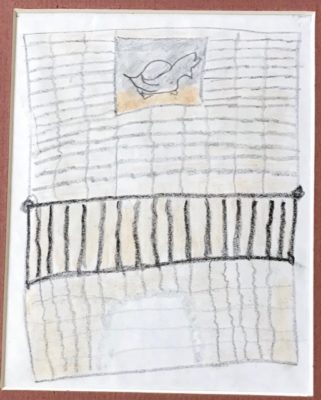
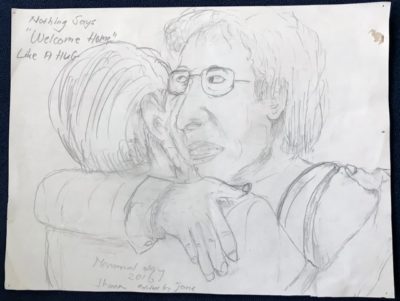
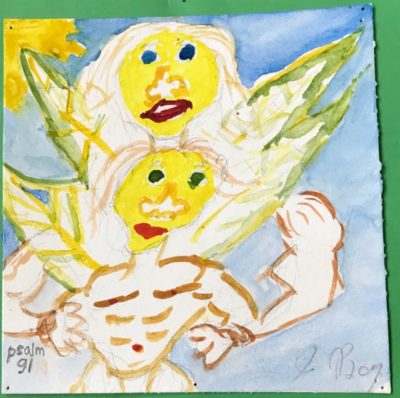
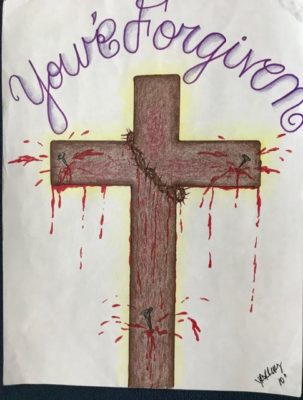
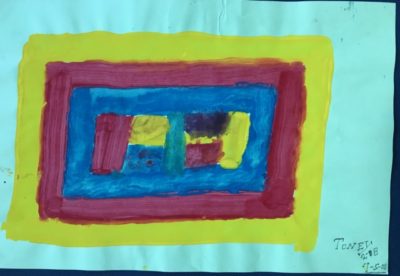
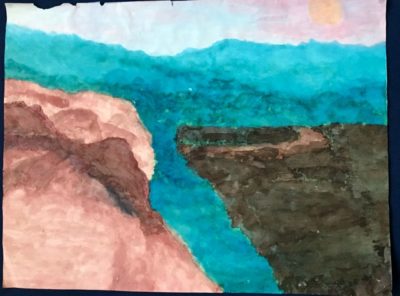
For many years, I noticed how whole I felt while helping the men at Christ House – and how empty or dismembered I felt when I left. Over the 25 years that I have been privileged to offer the weekly workshop at Christ House, there has been a mysterious healing inside of me. Now I feel whole and at home in the world, whether I am at Christ House or not. I believe that Elizabeth O’Connor was right about doing the work of call: “…when it is true vocation, [call] always corresponds in some mysterious way to the work that goes on within us.’’